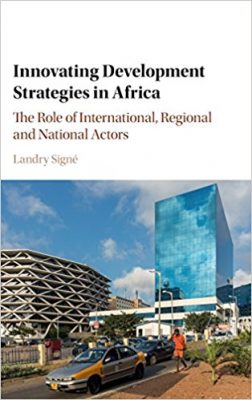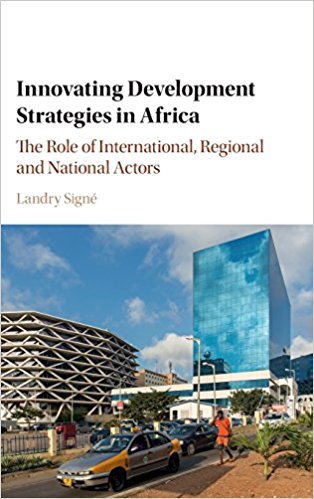 Author: Landry Signe
Author: Landry Signe
Publisher: Cambridge University Press -208 pages
Book Review by: Paiso Jamakar
In a 2016 report by the International Monetary Fund on shares of world gross domestic product by continent, Africa had only a $2.19 trillion share, or less than a 3 percent slice of the total global GDP pie of $75.21 trillion. Why is that the case? This book provides you a broad answer and the basic reasons for this.
Asia and the Pacific region had the largest slice, with 36 percent or $27.22 trillion, followed North America with 28 percent or $21.26 trillion; Europe with 25 percent or $19.07 trillion; and South America, with 5 percent or $3.94 trillion. Last in place after Africa was Oceania (Australia, New Zealand, and nearby nations) with less than 2 percent, or $1.468 trillion. The percentages do not add up to 100 percent as we just rounded them
Africa, the author points out in the context of this book, refers to the 48 countries in its sub-Saharan region, excluding the newly-formed South Sudan.
Landry Signe gives us an overview of the economic, political, and social development strategies that have been used in this continent for the last 50 years or so, from the 1960s until 2017, when this book was published. Basically, here are some growth strategies that came about in that continent, and evolved over the course of this time:
- African nations have shifted from having the state being the main player and sole driver of change and progress to adopting strategies of integration and regional cooperation.
- The initial dominant role of public institutions such as governments and state-run enterprises, have reduced. Over time, private sector entities have become a larger component of the development process.
- Poverty-reduction strategy papers (PRSPs) and poverty reduction growth fund (PGRF) were adopted by countries to promote economic development and reduce poverty levels.
- The New Partnership for Africa’s Development (NEPAD) aimed at integrating the region into the process of globalization “in a beneficial way,” wherein countries de-emphasized their individual strategies and emphasized a unified pan-African development strategy
To give you a sort of bird’s eye view of the contents of this unique, well-researched, intensively documented book, we note below its chapters, sandwiched between its Introduction and Conclusion that are must-reads for you to gain a meaningful perspective:
Introduction: Political and Institutional Change in Africa: An Analysis of Innovations in Economic development Strategy since the Period of Independence
- Innovation in African Economic Development Strategy: Literature Review and Conceptual Clarification
- Theoretical and Methodological Framework: Ideas, Interests, Institutions, Time, and the Role of International, Regional and National Actors in Economic Development Strategy
- Time, Historical Context, and Innovation in African Development Strategies
- Ideas, Values, Paradigms, and Policy Innovation in Africa
- Interests, Strategies, and Policy Innovation in Africa
- How do International, Regional, and National Actors Affect Innovation in African Development Strategies?
Conclusion: Toward a New Analysis of Change in Political Science: Political and Institutional Innovation in the Light of African Development Strategies
A good place to get broader and deeper perspectives on the basic points made in this book is in chapter 6. The author notes that the three levels of ‘actors’ – international, regional and national – have been involved in most of the innovation in development strategies in Africa.
The international level actors are the International Monetary Fund and the World Bank (international financing institutions or IFIs); the regional level actors are the various organizations of African countries as well as United Nations agencies such as the U.N. Development Program or UNDP, the United Nations International Children’s Educational Fund or UNICEF, and the United Nations Conference on Trade and Development or UNCTAD; and the national level actors are the African countries themselves, particularly their heads of state.
The innovations in development strategies that the author covers and discusses are of basically three types:
- Innovation through Diffusion by Unilateral Imposition – basically a top-down process of diffusion from the IFIs down through structural adjustment programs (SAPs ) to the participating countries
- Innovation through Learning and Adaptation – from the IFIs to the African countries through two ways:
- Mobilization of civil society
- Through the U.S. agencies such as UNCTAD, UNICEF UNDP,
- Innovation through Conversion – the African countries take the initiative of converting the innovation into SAPs, PRSPs and PGRF in two ways:
- With the financial assistance of IMF and the World Bank
- Mobilization of civil society
Figures in the book illustrating these innovation strategies will provide you a clear picture.
Author:
Landry Signe is a Distinguished Fellow at Stanford University’s Center for African Studies, Professor of Political Science and Senior Adviser to the Chancellor and Provost on International Affairs at the University of Alaska – Anchorage Woodrow Wilson International Center Public Policy Fellow, Chairman of the Global Network for Africa’s Prosperity. And Special Adviser to African and global leaders.
He is the author of numerous publications on the political economy of development with a focus on Africa and has a special interest in the politics of economic reform, institutional change, emerging and frontier markets, global political economy, post-conflict reconstruction, political regimes, state capacity, public service delivery, and governance.
He is the recipient of more than 60 prestigious awards and distinctions from four continents, and has been honored as a World Economic Forum Young Global Leader, Desmond Tutu Fellow, and Andrew Carnegie Fellow and was listed as one of the “Top Ten Outstanding Young Persons in the World.” His work has appeared in The New York Times, the Washington Post and the Harvard International Review, among other media.







